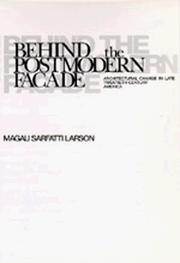| Listing 1 - 4 of 4 |
Sort by
|

ISBN: 0520081358 0520201612 0585299714 Year: 1993 Publisher: Berkeley Los Angeles London University of California Press
Abstract | Keywords | Export | Availability | Bookmark
 Loading...
Loading...Choose an application
- Reference Manager
- EndNote
- RefWorks (Direct export to RefWorks)
Born amidst the furious social changes of the mid-1960's, postmodern architecture redefined the purposes of a prestigious profession. In this work, Magali Sarfatti Larson gives a bold and comprehensive account of the social, economic, and ideological shifts that cracked the modernist dogma and reintroduced historical allusion, diversity, and ornament into architectural discourse and practice. She connects the socioeconomic realities of postindustrial America to the specific architects who shape the space around us in an arena where practical constraints - such as the organization of firms, clients, and commissions - determine what can be built. Modernism, which took shape in the war-shattered Europe of the 1920's, was energized by a powerful desire for radical social reform. Later it came to express the social and economic domination of corporate capitalism symbolized by interchangeable glass-box cityscapes. As modernism exhausted itself both economically and ideologically, architects like Robert Venturi and Michael Graves began to call for new principles and to embrace the motifs and methods of architectural history and popular culture. The demise of modernism threw the architectural profession into a still unresolved crisis in which parts of the profession questioned not only its discourse but also the architect's subservience to the predominant structures of power. Sarfatti Larson analyzes the complex tensions that exist between economic interest, professional status, and architectural product. She explores, for instance, the symbolic reward systems that consist of awards and recognition by prestigious journals and panels. She deftly exposes the inner workings of a profession in a precarious social position, struggling to ensure the status, place, and power of architects in American society, even as that society redefines the very purpose of architecture. Behind the Postmodern Facade draws from extensive interviews with pivotal architects - from Philip Johnson, who was among the first to introduce European modernism to America, to Peter Eisenman, who condemns what has already become a "traditional post-modernism" and chooses instead to provoke clients and viewers with a new "deconstructionist" style. This book synthesizes sociological research and theory in a novel approach to the artistic field where postmodernism began: Sarfatti Larson proposes a cultural history which reveals precisely how architecture "happens" and what has become of the profession in the postmodern era. Behind the Postmodern Facade makes a ground-breaking contribution to the study of culture and the sociology of knowledge, as well as to architectural and urban history. It will make essential reading for anyone seeking insight into the postmodern phenomenon.
Architectural practice --- -Architectural services marketing --- -Architecture --- -Architects --- -Technological innovations --- Psychology --- Architectural services marketing --- Architecture --- Architects --- Art, Architecture & Applied Arts --- Technological innovations. --- Psychology. --- Technological innovations --- United States --- -Professional employees --- Architecture, Western (Western countries) --- Building design --- Buildings --- Construction --- Western architecture (Western countries) --- Art --- Building --- Architect and client --- Design services --- Sales promotion --- Architectural services --- Design and construction --- Marketing --- Practice --- Vocational guidance --- anno 1900-1999 --- -Architecture, Western (Western countries) --- Architecture, Services d' --- Architectes --- Pratique --- Innovations --- Psychologie --- Professional employees --- Architecture, American --- Architecture, Primitive --- United States of America
Book
ISBN: 0520039505 0520029380 9780520029385 Year: 1977 Publisher: Berkeley (Calif.): University of California press,
Abstract | Keywords | Export | Availability | Bookmark
 Loading...
Loading...Choose an application
- Reference Manager
- EndNote
- RefWorks (Direct export to RefWorks)
Occupational prestige --- Prestige professionnel --- Professional socialization --- -#SBIB:316.334.1O100 --- Career patterns --- Careers --- Jobs --- Professional services --- Interprofessional relations --- -Filosofie van het onderwijs --- Professional socialization. --- Sociology of occupations --- Professions --- Social aspects --- Aspect social --- #SBIB:316.334.1O100 --- Filosofie van het onderwijs --- Socialization --- Occupations --- Vocational guidance --- Professions - Social aspects - United States
Book
Year: 1969 Publisher: Berkeley, Calif. University of California
Abstract | Keywords | Export | Availability | Bookmark
 Loading...
Loading...Choose an application
- Reference Manager
- EndNote
- RefWorks (Direct export to RefWorks)

ISBN: 0847819450 0847819469 Year: 1996 Publisher: New York, N.Y. Rizzoli
Abstract | Keywords | Export | Availability | Bookmark
 Loading...
Loading...Choose an application
- Reference Manager
- EndNote
- RefWorks (Direct export to RefWorks)
Modern [styles and periods] --- Architecture --- architecture [discipline] --- Quigley, Rob Wellington --- anno 1900-1999 --- anno 2000-2099 --- California --- United States --- History --- Modern [style or period] --- Criticism and interpretation. --- United States of America
| Listing 1 - 4 of 4 |
Sort by
|

 Search
Search Feedback
Feedback About UniCat
About UniCat  Help
Help News
News